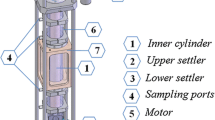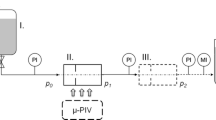Abstract
This paper reports on original experimental data of mixing in two-phase Taylor–Couette flows. Neutrally buoyant particles with increasing volume concentration enhance significantly mixing of a passive tracer injected within the gap between two concentric cylinders. Mixing efficiency is measured by planar laser-induced fluorescence coupled to particle image velocimetry to detect the Taylor vortices. To achieve reliable experimental data, index matching of both phases is used together with a second PLIF channel. From this second PLIF measurements, dynamic masks of the particle positions in the laser sheet are determined and used to calculate accurately the segregation index of the tracer concentration. Experimental techniques have been thoroughly validated through calibration and robustness tests. Three particle sizes were considered, in two different flow regimes to emphasize their specific roles on the mixing dynamics.


















Similar content being viewed by others
Abbreviations
- A :
-
Area of pixels with value 1 (–)
- C :
-
Concentration (–)
- \({\overline{C}}\) :
-
Mean concentration (–)
- e :
-
Gap width (m)
- H :
-
Height (m)
- I :
-
Segregation index (u.a.)
- m :
-
Azimuthal wavenumber (–)
- n :
-
Refraction index (–)
- \(R_{\mathrm{d}}\) :
-
Initial decay rate (–)
- \(R_{\mathrm{e}}\) :
-
Stator radius (m)
- \(R_{\mathrm{i}}\) :
-
Rotor radius (m)
- \(Re_{\varOmega }\) :
-
Reynolds number (–)
- r :
-
Radial coordinate (m)
- Tc :
-
Rotational period (s)
- \(t_{1/2}\), \(t_{90}\), \(t_{99}\) :
-
Mixing times (s)
- \({\varGamma }= H/e\) :
-
Aspect ratio (–)
- \({\varGamma }\) :
-
Mean shear rate (\({\text{s}}^{-1}\))
- \(\lambda\) :
-
Axial wavelength (–)
- \(\nu\) :
-
Kinematic viscosity (\({\text{m}}^2\,{\text{s}}^{-1}\))
- \({\varOmega }\) :
-
Rotation rate (\(\text{rad}\,\text{s}^{-1}\))
- \(\rho\) :
-
Density (\(\text{kg}\,\text{m}^{-3}\))
- \(\sigma\) :
-
Standard deviation (–)
- \(\sigma ^2\) :
-
Variance (–)
- DMSO:
-
Dimethyl-sulfoxide
- KSCN:
-
Thiocyanate of potassium
- PIV:
-
Particle image velocimetry
- PLIF:
-
Planar laser-induced fluorescence
- sCMOS:
-
Camera (scientific complementary metal oxide semi-conductor)
- SVF:
-
Spiral vortex flow
- TVF:
-
Taylor vortex flow
- WVF:
-
Wavy vortex flow
- c:
-
Critical
- i:
-
Relative to the rotor
- e:
-
Relative to the stator
- 0:
-
Relative to the origin value
- rz :
-
In the vertical visualization plane
References
Andereck D, Liu SS, Swinney HL (1985) Flow regimes in a circular Couette system with independently rotating cylinders. J Fluid Mech 164:155–183
Bouche E, Cazin S, Roig V, Risso F (2013) Mixing in a swarm of bubbles rising in a confined cell measured by mean of PLIF with two different dyes. Exp Fluids 54(6):1552
Bruchhausen M, Guillard F, Lemoine F (2005) Instantaneous measurement of two-dimensional temperature distributions by means of two-color planar laser induced fluorescence (PLIF). Exp Fluids 38(1):123–131
Campero RJ, Vigil RD (1997) Axial dispersion during low Reynolds number Taylor–Couette flow: intra vortex mixing effect. Chem Eng J 52:3305–3310
Coles D (1965) Transitions in circular Couette flow. J Fluid Mech 21:385–425
Davis MW, Weber EJ (1960) Liquid–liquid extraction between rotating concentric cylinders. Ind Eng Chem 52:929–934
Desmet G, Verelst H, Baron GV (1996a) Local and global dispersion effect in Couette–Taylor flow—I. Description and modeling of the dispersion effects. Chem Eng J 51:1287–1298
Desmet G, Verelst H, Baron GV (1996b) Local and global dispersion effect in Couette–Taylor flow—II. Quantitative measurements and discussion of the reactor performance. Chem Eng J 51(8):1299–1309
Dherbécourt D, Charton S, Lamadie F, Cazin S, Climent E (2016) Experimental study of enhanced mixing induced by particles in Taylor–Couette flows. Chem Eng Res Des 108:109–117
Dussol D, Druault P, Mallat B, Delacroix S, Germain G (2016) Automatic dynamic mask extraction for PIV images containing an unsteady interface, bubbles, and a moving structure. Comptes Rendus Mécanique 344:464–478
Dusting J, Balabani S (2009) Mixing in Taylor–Couette reactor in the non wavy flow regime. Chem Eng Sci 64:3103–3111
Dutcher C, Muller SJ (2009) Spatio-temporal mode dynamics and higher order transitions in high aspect ratio newtonian Taylor–Couette flows. J Fluid Mech 641:85–113
Esser A, Grossmann R (1996) Analytic expression for Taylor–Couette stability boundary. Phys Fluids 8:1814–1819
Kataoka K, Takigawa T (1981) Intermixing over cell boundary between Taylor vortices. AIChE J 27:504–508
Kataoka K, Hongo T, Fugatawa M (1975) Ideal plug-flow properties of Taylor-vortex flow. J Chem Eng Jpn 8:472–476
Kataoka K, Doi H, Komai T (1977) Heat and mass transfer in Taylor-vortex flow with constant axial flow rate. Int J Heat Mass Transf 57:472–476
Kittler J, Illingworth J (1988) A survey of the hough transform. Comput Vis Graph Image Process 44:87–116
Lanoë JY (2002) Performances d’une colonne d’extraction liquide-liquide miniature basée sur un écoulement de Taylor–Couette. In: ATALANTE conference, Scientific report, CEA, pp 244–251
Lindken R, Merzkirch W (2002) A novel PIV technique for measurements in multiphase flows and its application to two-phase bubbly flows. Exp Fluids 33(6):814–825
Majji S, Banerjee M, Morris J (2018) Inertial flow transitions of a suspension in Taylor–Couette geometry. J Fluid Mech 835:936–969
Metzger B, Rahli O, Yin X (2013) Heat transfer across sheared suspensions: role of the shear-induced diffusion. J Fluid Mech 724:527–552
Nemri M, Climent E, Charton S, Lanoe JY, Ode D (2013) Experimental and numerical investigation on mixing and axial dispersion in Taylor–Couette flow patterns. Chem Eng Res Des 91:2346–2354
Nemri M, Cazin S, Charton S, Climent E (2014) Experimental investigation of mixing and axial dispersion in Taylor–Couette flow patterns. Exp Fluids 55:1769
Nemri M, Charton S, Climent E (2016) Mixing and axial dispersion in Taylor–Couette flows: the effect of the flow regime. Chem Eng Sci 139:109–124
Ottino JM (1989) The kinematics of mixing: stretching, chaos and transport. The Press Syndicate of the University of Cambridge, Cambridge
Rudman M (1998) Mixing and particle dispersion in the wavy vortex regime of Taylor–Couette flow. AIChE J 44(5):1015–1026
Souzy M, Lhuissier H, Villermaux E, Metzger B (2017) Stretching and mixing in sheared particulate suspensions. J Fluid Mech 812:611–635
Tam WY, Swinney HL (1987) Mass transport in turbulent Taylor–Couette flow. Phys Rev A 36:1374–1381
Wilkinson N, Dutcher C (2018) Axial mixing and vortex stability to in situ radial injection in Taylor–Couette laminar and turbulent flows. J Fluid Mech 854:324–347
Acknowledgements
The authors would like to thank CEA for financial support and the technical support of Moise Marchal (IMFT) and Hervé Roussel (CEA).
Author information
Authors and Affiliations
Corresponding author
Additional information
Publisher's Note
Springer Nature remains neutral with regard to jurisdictional claims in published maps and institutional affiliations.
Rights and permissions
About this article
Cite this article
Rida, Z., Cazin, S., Lamadie, F. et al. Experimental investigation of mixing efficiency in particle-laden Taylor–Couette flows. Exp Fluids 60, 61 (2019). https://doi.org/10.1007/s00348-019-2710-9
Received:
Revised:
Accepted:
Published:
DOI: https://doi.org/10.1007/s00348-019-2710-9




